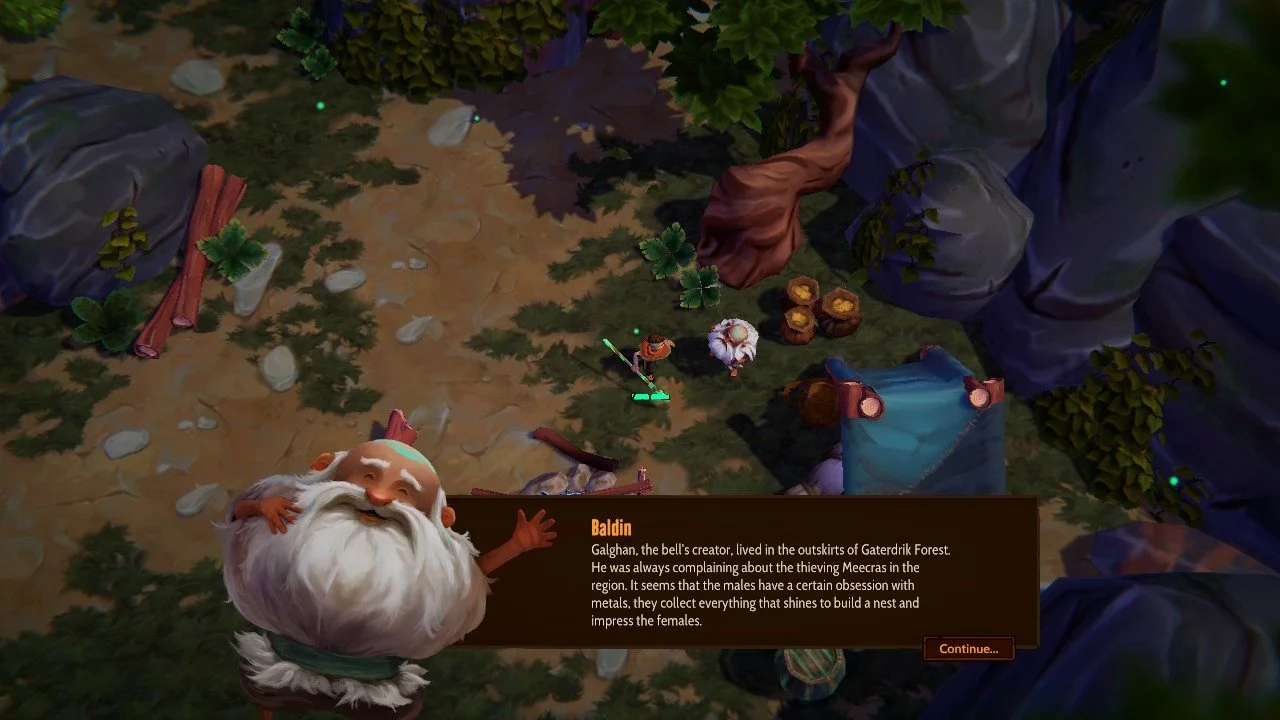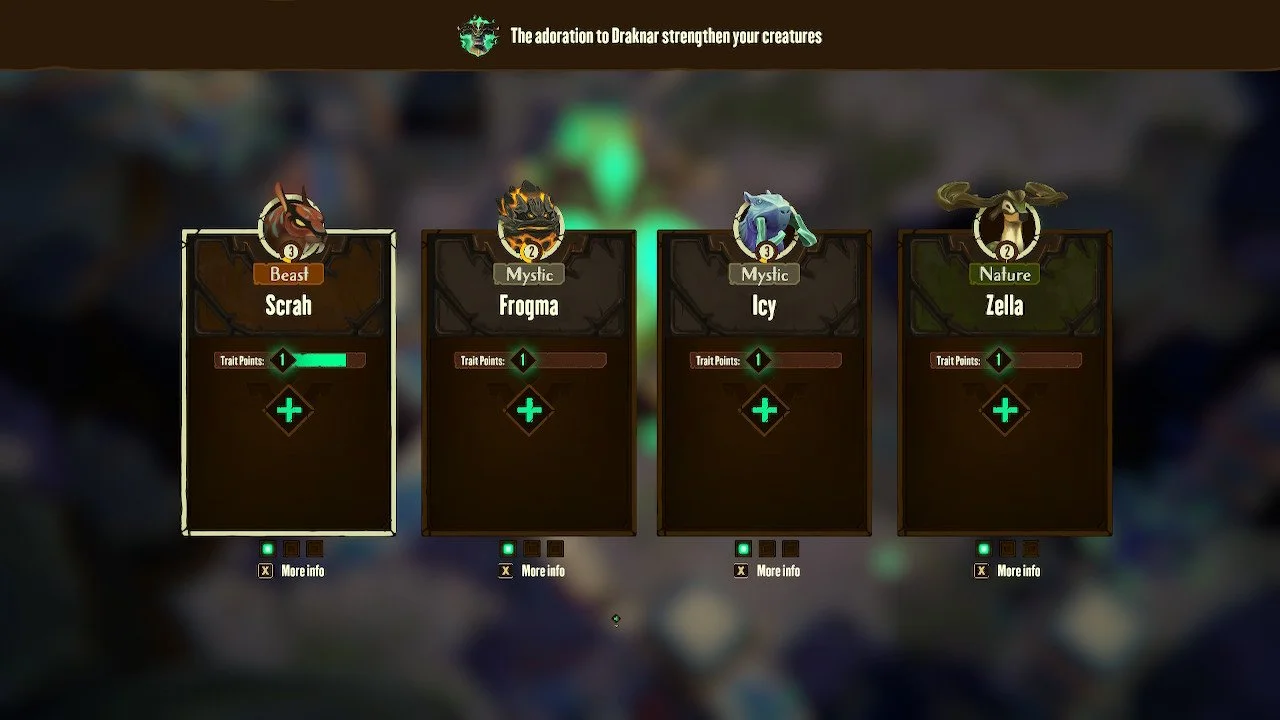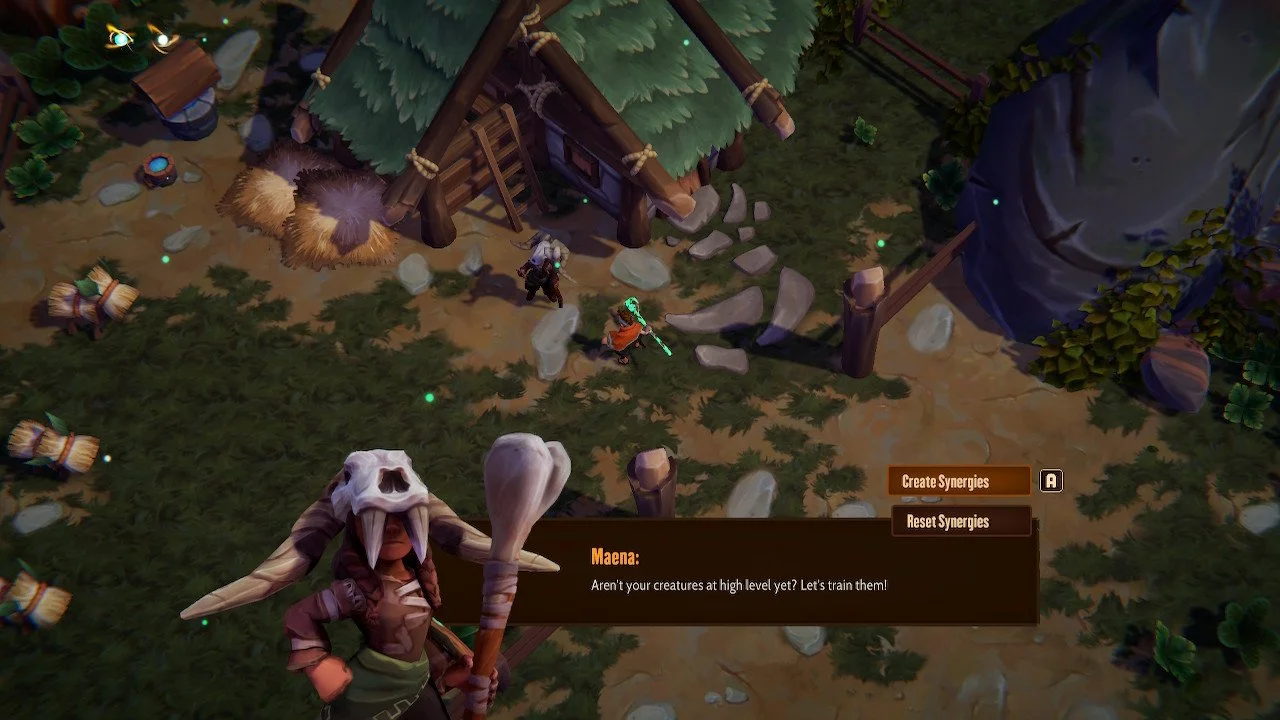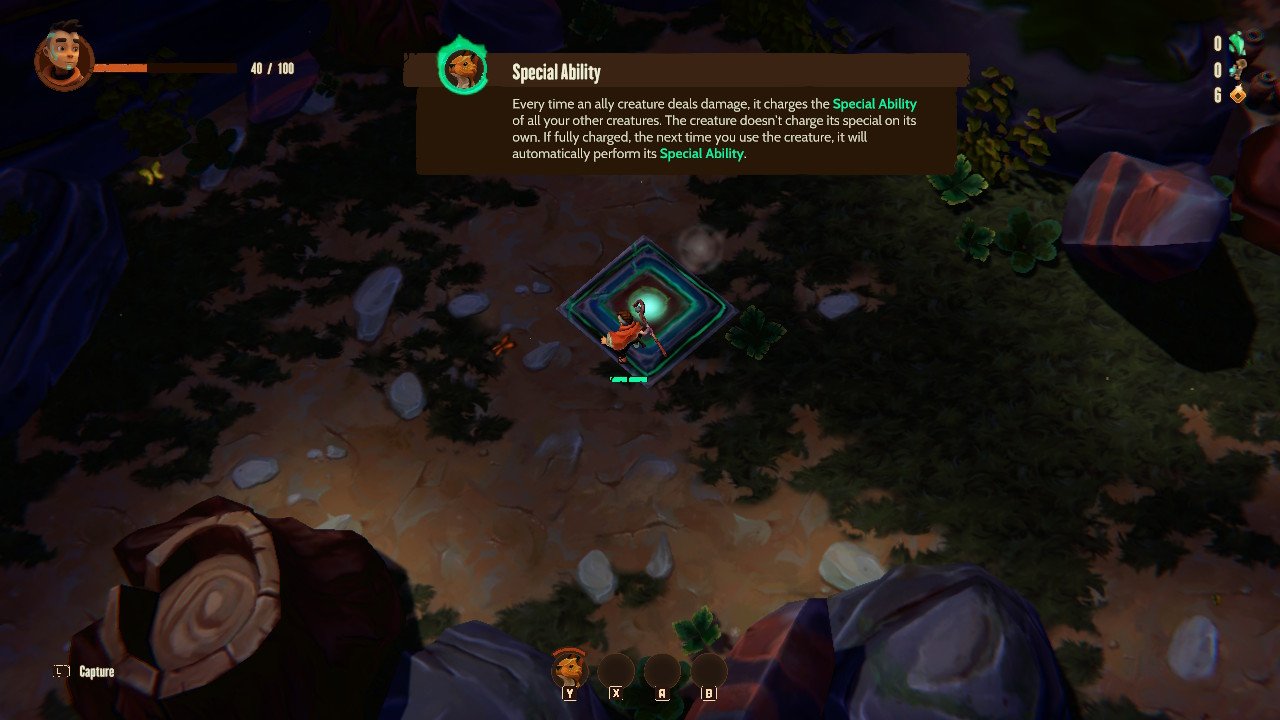Gotta Catch’em All!
While the monster-catching genre has produced some absolutely fantastic alternatives to Pokémon over the years, with Cassette Beasts being one of the most impressive in recent memory, taking that formula and adapting it to an entirely different genre is something we don’t normally see. Adore, developed by Brazil-based Cadabra Games presents its Pokémon-like formula through an isometric adventure game, almost feeling like it’s Diablo meets Pokémon, even if that idea is more impressive than what was delivered.
Taking place in the world of Gaterdrik, the story follows the fall of a dragon named Draknar. During a battle against their rival, Ixer, Draknar is seemingly killed, only to resurrect their power within an Adorer named Lukha. Adorers, who worship Draknar, can tame and use a variety of monsters that make up the world of Gaterdrik. As Lukha is beginning their adventure, they are killed by Ixer and brought back to life through Draknar, taken to a small village hub location where you’ll regroup, power-up, and then take the fight back to Ixer once and for all.
While the concept of this story is solid, the execution doesn’t always hit in the ways where it should. This is largely due to a lack of memorable characters, stand-out story moments, and a lack of its story being anything more than a bunch of retreaded mission types and dialogue boxes and the occasional boss encounter. It also doesn’t help that all of the game’s text is nearly unreadable when playing Adore on the go. This font size is barely legible on the OLED, let alone the OG Switch or the SwitchLite, which I would assume is practically impossible to read. While the font size is more-or-less fine when playing on a big tv, at a moderate range, its use here for portability is absolutely painful to the eyes. Even if the game had been voiced, the tutorials, skills, and other avenues for text would still be present.
Adore’s central gameplay hook is that you’ll capture monsters during your travels in a variety of procedurally generated locales, all themed around a core environment. These “dungeons” contain a select variety of unique monsters, items, and challenges, all indicated on a mission prep screen so that you can tailor your adventure to collect the things you want. You’ll also have expeditions to take on as well, which grant more rewards and almost act like special missions, even if they pull from the same visual assets as every other level.
As you enter into each location, you’ll have to clear that room’s allotment of monsters to allow you to continue on. You can either catch them, by using Gaterdrik Particles, a resource you’ll find scattered across most maps, with more of them being needed to catch more powerful monsters, or defeat them outright, using your team of four monsters to get the job done. You take command of Lukha, using the face buttons to “throw” out your monsters as you can roll around and try not to get hit. While your monsters will almost always go after the nearest creature, they can sometimes randomly run into walls or go to attack a monster that is furthest away. It doesn’t always happen, but when it does, and you see half their health get chopped off as a result of that wandering, it isn’t a great feeling.
While combat largely works, it has one major flaw. During skirmishes, the camera will focus on your creatures, so if you attempt to move too far away with Lukha, they will run off-screen, likely into other monsters or the traps that major bosses will unleash. As for your monsters, they work off a stamina cool-down and can be tossed out, two at a time, unless you use particular skills to offload more of them at once. At they return back to you, or if you manually recall them, which is great for taking cheap shots at bosses, you’ll earn back stamina that allows you to toss them out again. Repeat these steps with your squad and you can often double-team nearly anything.
You can also upgrade them with synergies that work alongside monsters of that same type, allowing for perks and bonuses to trigger when used. This is done by giving them a monster essence of a fellow monster, which also allows you to select a passive skill that is triggered when used alongside a monster of that type. It’s a fairly good system as it rewards you for playing around with a team build and mixing and matching your squad.
You’ll also earn skill points by leveling them up or finding Darknar shrines to speed that process up. I will say that the level-up menu within each monster was something I wasn’t able to find for some time, largely stumbling upon it as it’s not clear how just exactly how to do it. Each monster has a status screen, with X on the Switch allowing you to shift pages within their status, one of them being the skills screen. This menu is extremely janky to navigate as skills are slotted diagonal, and sometimes I had to back out and go back in to even select them.
Much like the small text, the UI for your monsters when portable is extremely tiny. If a monster has a special attack building, the animation of it flowing around their icon can block some of their health bar, which is shown as a pixel-width red bar. This caused me to toss out monsters that were nearly dead, thinking that they still had some life left in them. While monsters don’t die, they instead pull from your own personal health pool should they take damage. This is where taking cheap shots pays off as you can get in a few hits and manually retract them back to you before the enemy can respond. It also helps to select two monsters that pair well together, or always having a monster that has a healing spell, even if its use is rather slow; every bit helps. While you can always carry food on you, grinding away at earning ingredients feels like more of a chore than it should be.
If a monster has been defeated, it will become cursed. This can be lifted by leaving them back at the village during a run. As you return to the village, you can refill the health of those still alive by interacting with an altar at the exact area you teleport into the village. This also allows you to select your team, increase the size of your stable, or recruit additional monsters you’ve managed to capture, but your slots were full. It’s great that captured monsters don’t fade into the ether should your slots had been full, that is greatly appreciated.
If Lukha dies, and he often will, he will drop all his gold and some of the upgrade materials you’ve earned. While the level select will tell you where those dropped resources are, indicated by a yellow skull, it allows you to dive back in and retrieve them. You do need to finish that level to leave with them; however, as there is no immediate recall without sacrificing them. If this is a level where you are struggling on a boss, then you’ll need to push through it in order to go back to the village with everything on your person.
Capturing a monster is done one of two ways. You can use the Gaterdrik Particles to capture them, depending on their rarity and how many Particles you’ll need, which can take a while to capture them as you hold down L to stay within a cone that extends out of them or bring their health low enough with some weaker attacks to decrease the time needed to stay in that cone. As they are unaware or defensive, that cone’s placement will change, often having you take a few strikes as you attempt to capture them. It’s an alright system but it can be very easy for your monsters to accidentally kill something if you are not careful.
To aid Lukha in the battles ahead, you can equip runes to him that boost particular skills from additional damage for your monsters, increasing their charge rate, to boosting your health or speed; each rune can often be the difference between life and death. Well, maybe not that extreme, but they certainly can keep you alive. As you find them, you’ll encounter a storage currency called fragments in the form of a green crystal. These can be used to increase the size of your stable or increase the storage of runes that Lukha can hold at once. Both are important, but you’ll need to grind away at levels that contain those resources to get the most out of these systems.
Diving back into levels to earn those resources, or food items to create dishes to boost your health or stamina, or even earning gold, can feel extremely grindy, with no real differences in levels than what you are being rewarded with. Even story missions that have you taking on a boss or tracking down rarer monsters, often feel like the same mission in the same locations. There are a small set of environments that really provide entirely different aesthetics, but the general gameplay is entirely the same run over and over again. And you’ll get used to those new environments only a few run in, allowing what once was fresh to feel outdated and reused far too quickly. Each level has maybe three or four distinct rooms that connect through loading zones that you can fast-travel to once that room has been cleared.
To break up some of that repetition, you’ll encounter events that have you holding firm on a platform as it charges, to numerous others, spawning monsters around you while you attempt to complete the challenge. Regardless, the maze of locations you’ll travel to just feels endlessly grindy for all the wrong reasons. You’ll unlock a whole new location, but apart from minor set dressing, the exact avenue of gameplay is repeated here, with nothing new to shake it up. While runs are generally short, usually around 5-10 minutes, making this game great to play is short sessions, doing that same level dozens of times with no real change to what you are doing, apart from bringing in a different squad, starts to make the game lose a lot of its magic.
Adore can often be a good-looking game, borrowing that certain flavor of visuals that is pretty common in a lot of indie games. The key art itself is solid, with some great monster designs that while lacking that memorable standout, the character and monster art really do present a fun identity for the title. Since levels have that randomly generated format to them, only a few boss areas really stand out as being solid set pieces, usually at their entrance, with the rest of each environment being a series of level blocks and objects to produce mazes through or tend to allow the random placement of level parts to function.
Visuals aside, performance on the Switch just isn’t great. While the game attempts to hold a consistent framerate with a 60fps target, I could feel drastic drops as I moved around the levels, seeing a jerkiness to the animation as it was loading something up ahead. This was also present each time I went back to the village, easily having the game drop to either 30 or below. Thankfully, I rarely experienced these drops during combat, never resulting in a death that wasn’t my fault. I could also tell that the resolution took a big dive when playing portable as even on the OLED, the visual clarity of playing it on a tv was simply not there. And again, I want to point out that if you have a SwitchLITE, I strongly do not recommend this game as you won’t have the luxury of playing it on the tv to alleviate the incredibly small font size and UI.
While its music is actually rather good, I didn’t find that it fits the tone of exploring and taking part in battles. Nearly every track you adventure alongside to feels like a theme used when touring the village. You also will find that a few of the tracks tend to replay far too often, getting them stuck in your head, but not in the way a good tune usually can. Again, solid music, but its implementation here leaves a lot to be desired.
Adore looked to be a pretty fun adventure, taking the Pokémon formula and a bit of Diablo, or even Torchlight from both a gameplay and aesthetics point of view, and creating a unique spin on commanding a group of monsters to fight for you. While combat is pretty enjoyable, and the progression systems offer a wealth of unique options, the implementation of so many of its systems and UI elements significantly hold the game back. From uninspired mission objectives to the game feeling incredibly grindy at times, to UI elements that are far too tiny for that portable screen, not to mention the pretty drastic frame dips, Adore certainly misses a few swings as it attempts to knock it out of the park. I do believe there is a good game here, one that I have seen numerous glimpses of, but so much of what is here feels like a chore than something that allows its fun to come naturally, or even at all.
Developer - Cadabra Games. Publisher - Cadabra Games. QuByte Interactive. Released - August 3rd, 2023. Available On - Nintendo Switch, Xbox One/Series X/S, PS4/5, PC. Rated - (E 10+) - Fantasy Violence. Platform Reviewed - Nintendo Switch. Review Access - A review code was provided by the PR/publisher for the purpose of this review.


















Jeff is the original founder of Analog Stick Gaming. His favorite games include The Witcher III, the Mass Effect Trilogy, Hi-Fi Rush, Stellar Blade, Hellbade: Senua’s Sacrifice, and the Legend of Heroes series, especially Trails of Cold Steel III & IV.